
The oceans are home to 99% of the Earth’s biosphere and cover 71% of the planet. Dynamic and fragile, they provide habitat for an extraordinary diversity of life and social-ecological systems, including fisheries that have sustained human populations for millennia.
The UBC Institute for the Oceans and Fisheries (IOF) contributes to a transformative global shift toward sustainable coastal ecosystems, oceans and fisheries. It brings together a community of Canadian and international experts in ocean and freshwater species, systems, economics, and issues, and provides new insights into how our marine systems function and the impacts of human activity on those systems.
Housed at Canada’s premier west coast university, the IOF enables collaboration across a broad range of research and policy—and includes a growing global network of partners in governments, coastal communities, non-profit organizations and peer institutions to address issues of local and global concern.
We envisage a world in which ocean and freshwater ecosystems are healthy and their resources are used sustainably and equitably; this requires a holistic approach to our methodology and research.
Addressing the consequences of human-induced climate change, including warming waters, overfishing, salinity, invasive species—while developing marine conservation plans that sustain and provide economic and social benefits—can only be achieved through a combination of research and outreach, as we seek to understand and address the overall impacts of our changing global environment on marine and freshwater ecosystems, and ecosystem services.
With integrated research and education programs that span the natural and social sciences, including; aquatic ecology, economics, zoology, anthropology, sociology, oceanography, marine geochemistry, microbiology, resource management and international maritime law, we are leading the way to healthy and sustainable marine and freshwater systems through excellent research, inspirational education, and innovative societal engagement.
Our Vision
A world in which the ocean and freshwater systems are healthy with their resources used sustainably and equitably.
Our Mission
To help grow healthy and sustainable marine and freshwater systems through excellent research, inspirational education, and innovative societal engagement.
IOF's four strategic themes are: People, Research, Education, and Engagement. Specific objectives from other cross-sectional themes, such as Equity, Diversity, Inclusion, and Wellbeing, have been integrated into the four strategic themes.
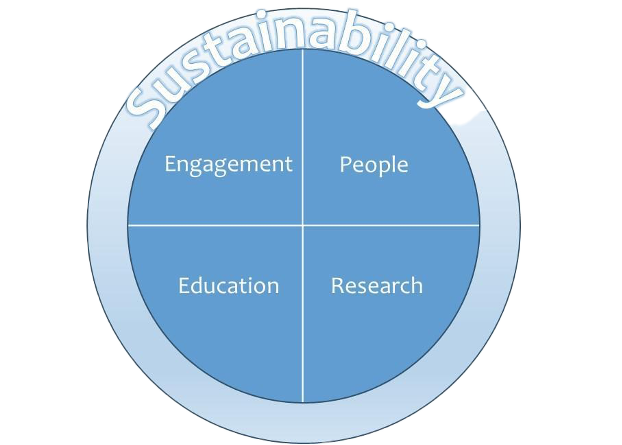
People: All members consider the IOF an inclusive, equitable, respectful and supportive workplace.
Research: The IOF is a hub for internationally recognised excellent research and scholarly activity on ocean and aquatic ecosystems, and fisheries.
Education: All IOF students and postdoctoral fellows feel fully supported with excellent supervision, strong mentorship, robust teaching, and careful attention paid towards their long-term success.
Engagement: Collaborative stakeholders, rights-holders, and other groups who are engaged and co-developing research around ocean and aquatic ecosystems, and fisheries regard the institute as a responsive, respectful, and supportive partner.
Sustainability: The IOF’s activities amplify its scholarly contributions to environmental sustainability on local and global scales.
The story so far...
| 2025 | On July 1, 2025, the Institute for the Oceans and Fisheries will begin celebrating its 10th Anniversary. |
| 2024 | The Sea Around Us initiative celebrated its 25th Anniversary. |
| 2022 | The Centre for Indigenous Fisheries is developed, based on an earlier Aboriginal Fisheries Research Unit, with Dr. Dianne Newell as Interim Director and Dr. Andrea Reid (Nisga'a Nation) as Principal Investigator. |
| 2019 | IOF begins its own graduate program, welcoming its first cohort of students from within Canada and internationally to continue training under the IOF tradition of excellent leadership and research. |
| 2015 | On July 1, 2015, the Fisheries Centre became the Institute for the Oceans and Fisheries, approved by UBC's Senate, with an expanded mandate for collaboration and impact across disciplines and sectors. |
| 2005 | 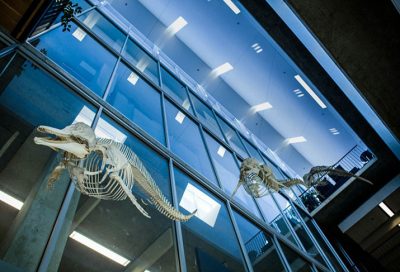 The Aquatic Ecosystems Research Laboratory (AERL) opens, giving the Fisheries Centre a new 55,000 square-foot home. Built around an atrium that connects the four floors of the building, the AERL provides a home for collaboration between natural and social scientists working on scientific, economic, sociological, and environmental aspects of aquatic ecosystems. The Aquatic Ecosystems Research Laboratory (AERL) opens, giving the Fisheries Centre a new 55,000 square-foot home. Built around an atrium that connects the four floors of the building, the AERL provides a home for collaboration between natural and social scientists working on scientific, economic, sociological, and environmental aspects of aquatic ecosystems. 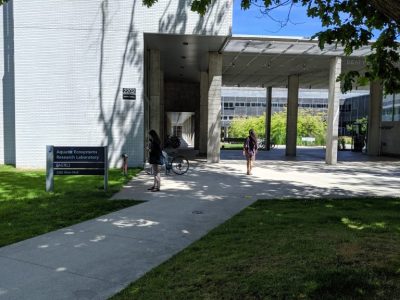 At the heart of the new facility is an immersion laboratory, offering decision makers an opportunity to visualize the impact of policy decisions in real time using sophisticated computer-generated images of underwater and coastal habitats. The lab is also used for integrating the inputs of sensors tracking electronically tagged marine mammals, and for monitoring BC ecosystems through arrays of sensors. The $8.9-million AERL facility is funded by the Canada Foundation for Innovation and is certified LEED Gold. At the heart of the new facility is an immersion laboratory, offering decision makers an opportunity to visualize the impact of policy decisions in real time using sophisticated computer-generated images of underwater and coastal habitats. The lab is also used for integrating the inputs of sensors tracking electronically tagged marine mammals, and for monitoring BC ecosystems through arrays of sensors. The $8.9-million AERL facility is funded by the Canada Foundation for Innovation and is certified LEED Gold. |
| 2003 |
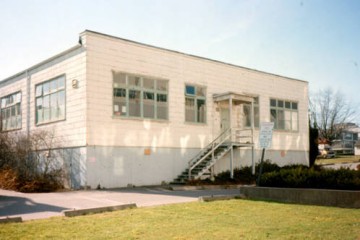 Hut B-6, University of British Columbia Archives, UBC 105.1/259 The Fisheries Centre is relocated from UBC’s WWII-era ‘huts’ to the Lower Mall Research Station while a permanent new facility is constructed. The ‘temporary’ huts had housed the Fisheries Centre since its founding in 1993, but the accommodations divided research units amongst different sites and were generally regarded as unsatisfactory. |
| 1999 | 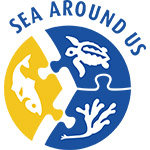 Principal Investigator Dr. Daniel Pauly launches the Sea Around Us initiative at the UBC Fisheries Centre, in collaboration with The Pew Charitable Trusts. Principal Investigator Dr. Daniel Pauly launches the Sea Around Us initiative at the UBC Fisheries Centre, in collaboration with The Pew Charitable Trusts. |
| Mid-1990s | Linkages are formed across the Pacific between the UBC Fisheries Centre and the International Centre for Living Aquatic Resources Management (ICLARM) in Manila, Philippines. The partnership leverages the Fisheries Centre’s leadership in Bayesian analysis and adaptive management, and ICLARM’s new integrating method for analyzing ecosystems. These research partnerships produce some of the most important conceptual advances in the history of fisheries science and aquatic ecology. |
| 1993 | 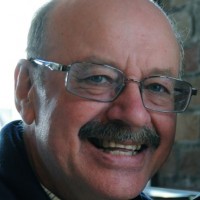 Professor Tony Pitcher is appointed as the Fisheries Centre’s first director. Coming to UBC from the Marine Resources Assessment Group at Imperial College London, Dr. Pitcher had previously worked as a project manager and researcher in Africa, Thailand, Sumatra, and the Adriatic. Professor Tony Pitcher is appointed as the Fisheries Centre’s first director. Coming to UBC from the Marine Resources Assessment Group at Imperial College London, Dr. Pitcher had previously worked as a project manager and researcher in Africa, Thailand, Sumatra, and the Adriatic. |
| 1991 | Sparked by a campus-wide debate about research in natural resources, a new Fisheries Centre is established to focus and promote the interdisciplinary study of fisheries. Professors William Neill, Mike Healey, and Carl Walters are absorbed into the new centre, bringing with them the accumulated ecological wisdom of IARE. |
| 1968 | The Institute of Fisheries is renamed the Institute of Animal Resource Ecology (IARE) to reflect its broadening interests. It includes a Co-operative Fisheries Unit that enables a cross-fertilization of ideas between fisheries scientists and other ecologists. Despite strongly influencing its field and providing in-service training for Canadian fisheries agencies, IARE was closed in the 1980s. |
| 1950s | The UBC Institute of Fisheries is founded by Dr. Peter Larkin, a respected professor of ecology, and British Columbia’s first Chief Fisheries Biologist. |
The Larkin Legacy
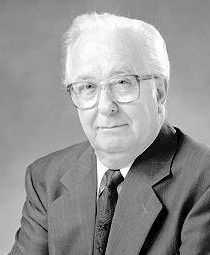
Peter Larkin, University of British Columbia Archives, UBC 18.1/2-1
Dr. Peter Larkin came to the UBC campus in 1948 as British Columbia’s first Chief Fisheries Biologist, with a joint appointment in the Department of Ecology where he established courses on ecology and population dynamics. Except for a four-year appointment as Director of the Government of Canada’s Pacific Biological Station (1963-1966), Dr. Larkin spent the remainder of his career at UBC, eventually becoming head of Zoology, Dean of Graduate Studies, and Vice-President of Research.
In 1952, Dr. Larkin established the BC Fisheries Research Section (a provincial division that became part of the Fisheries Centre) on the UBC campus. The co-location was an innovative liaison between research and management in an academic environment. In 1955, he founded the Institute of Fisheries in the Department of Zoology. He remained a member of the institute, which later became the IARE, until his retirement in 1989.
After retirement, Dr. Larkin remained active at UBC, heading a Royal Society of Canada evaluation unit. He was instrumental in establishing the North Pacific Universities Marine Mammal Research Consortium, which is administered by the Marine Mammal Research Unit in the Fisheries Centre.
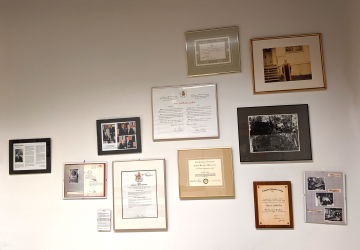
Various awards and memorabilia in the Larkin Room
Dr. Larkin served on the boards and councils of many prestigious national and international institutions. He received numerous honorary degrees and special awards, including the Order of Canada, the Order of British Columbia, the UBC Science Council Award for Career Achievement, and the Murray A. Newman Award for Conservation. He died in 1996.
The Institute for the Oceans and Fisheries hosts the annual Larkin Lecture and has named the Larkin Room in his honour. The room includes a collection of artwork and memorabilia. The Canadian Aquatic Resources Section of the American Fisheries Society (AFS) has established the Peter A. Larkin Memorial Fund to provide support for students to attend annual AFS meetings.
Full obituary: Northcote, T.D. (1996) Obituary of Peter Anthony Larkin. Rev. Fish Biol. Fish. 6: 374-377
AERL Building

The IOF is housed in the Aquatic Ecosystems Research Laboratory (AERL), an $8.9-million facility offering 55,000 square feet for research, collaboration and teaching. A four-storey open atrium connects interdisciplinary research groups throughout the building. Adjacent to the atrium, social spaces promote a sense of community and encourage interaction between students, faculty and staff. Large public rooms on the ground floor provide a welcoming environment for academic and social events. The upper floors house offices, digital laboratories and a variety of meeting spaces, such as the Hakai Node.
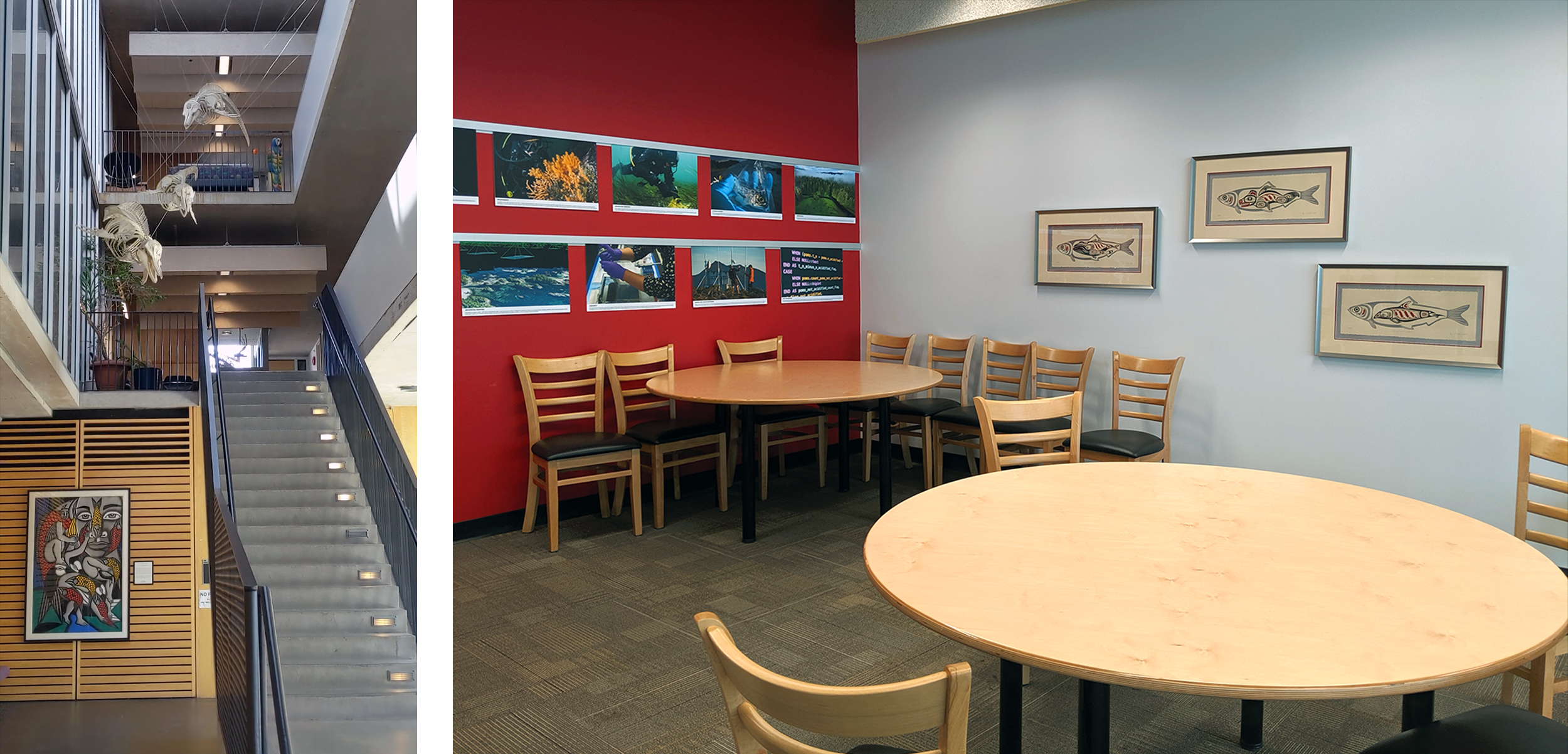
Pacific white-sided dolphin skeletons from the Marine Mammal Research Unit skeleton exhibit (left) and the Hakai Node (right).
The AERL building is certified LEED Gold and received the 2011 Lieutenant Governor’s Medal in Architecture for its sustainable design. The four-storey glass atrium brings daylight deep into the interior and pulls air into the building, limiting our dependency on conventional ventilation, air conditioning and artificial lighting.
Marine Mammal Skeleton Installations
Created in partnership between Petro-Canada and the Marine Mammal Research Unit (MMRU) at the University of British Columbia, this exhibit promotes a public understanding of marine mammals within the systems in which they live. A plaque describing the project is located on a pillar on the first floor.
Iinang Xaadee, or Herring People
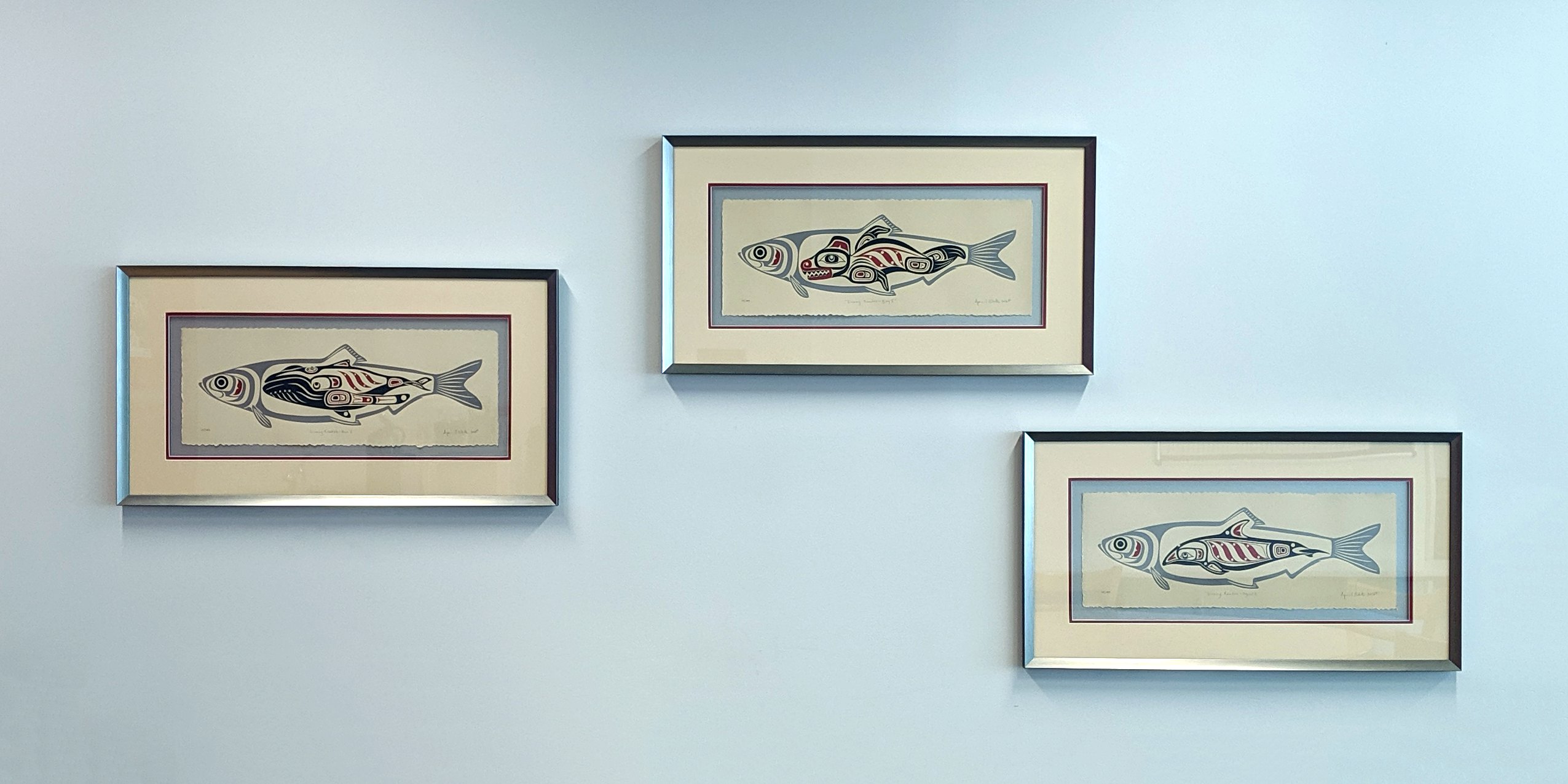
Artist: April White.
The Iinang Xaadee, or the Herring People Series, can be seen in the Hakai Node on the second floor of AERL. The series was a collaboration between the Institute for the Oceans and Fisheries and Haida artist April White.
Learn more about the meaning behind the paintings here
Associated Buildings
Through their affiliations with IOF partners, a number of our staff and students also work at other facilities on- and off-campus, depending on their lab and research interests, such as in the labs of the Earth Sciences Building (ESB).
Some researchers have also had the opportunity to conduct research at the Hakai Institute's facilities on Quadra Island and Calvert Island, at Fisheries and Oceans Canada West Vancouver, and at facilities in Nanaimo.
To see where else members of our IOF community work in the past or currently, please visit the respective lab or research unit's pages.
Wayfinding
Our Address
 Institute for the Oceans and Fisheries
Institute for the Oceans and Fisheries
The University of British Columbia
AERL, 2202 Main Mall
Vancouver, BC Canada
V6T 1Z4
Phone: +1 (604) 822-2731
Email: <info@oceans.ubc.ca>
Find Us
Our headquarters, the Aquatic Ecosystems Research Laboratory (AERL), is located on UBC's Main Mall between the Biological Sciences Building and the Beaty Biodiversity Museum. You can reach our building by a variety of methods.
Getting here
By Public Transport
One way of reaching AERL and UBC is by taking the bus, Skytrain or other forms of public transportation. Please see the Translink website for ways to reach us via public transportation in the Lower Mainland.
From UBC's Bus Loop, it takes around ten minutes by walking to reach IOF. Please see the map below for walking instructions from the Bus Loop
By Bike

The City of Vancouver has a list of cycling routes and maps that you can use to find your way to UBC. At AERL, there are bike racks outside where you can keep your bike during the day provided you bring your own bike lock.
UBC's Bike Kitchen also provides access to bike cages or bike lockers.
Bike share:
HOPR is the new bike share operator at UBC Vancouver! HOPR bikes are on campus, with over 100 bikes initially and plans to expand the fleet to over 200 bikes by September 2019. The service area will cover the entire UBC campus, including academic and neighbourhood areas.
By Car
On campus parking
There are a variety of places where you can park your car at UBC, with varied parking rates.
The parking lots closest to AERL are:
- Michael Smith Lot: street parking located in front of the Michael Smith Laboratories, near the UBC Bookstore. This is good for shorter term parking and only has one accessible parking spot.
- Health Sciences Parkade: Parkade located at corner of East Mall and Health Sciences with multiple accessibility parking spots. Best for longer term parking. Exit at southwest corner for easy access between buildings to AERL (follow signs to Beaty Biodiversity Museum).
You can buy a parking permit or pay by the hour. A map of parking lots at UBC can be found here on the UBC Parking website.
Car Share
All Vancouver area car sharing programs are active at UBC. Each have their own regulations, and designated parking spots across campus. Many offer discounts to UBC students, staff and faculty.
The nearest dropoff/pickup location to AERL for EVO and Modo car share programs is on the street in front of the Michael Smith Laboratories near the UBC Bookstore. Consult car share program maps for other dropoff/pickup locations.
The AERL building is equipped with an elevator which can move to the first, second and third and fourth floors.
The parking lots closest to AERL that have accessibility parking are:
- AERL Parking Lot: there is a parking lot behind the AERL building, which is good for shorter term parking and only has one accessible parking spot.
- Michael Smith Lot: street parking located in front of the Michael Smith Laboratories near the UBC Bookstore. This is good for shorter term parking and only has one accessible parking spot.
- Health Sciences Parkade: Parkade located at corner of East Mall and Health Sciences with multiple accessibility parking spots. Best for longer term parking. Exit at southwest corner for easy access between buildings to AERL (follow signs to Beaty Biodiversity Museum).
UBC also offers an Accessibility Shuttle across campus by reservation, with a shuttle stop location outside of the Earth Sciences building on Main Mall that is a few minutes away from the AERL building. See here for more information.
Should you have any questions about the accessibility of certain rooms in AERL, please contact Scott Finestone, IOF Manager, Finance and Facilities.